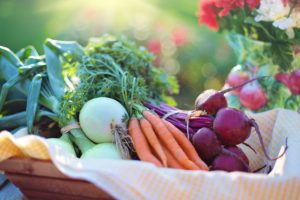Kidney Diet Education

Diet and nutrition are an important part of living well with kidney disease. As your kidney disease progresses, your dietary needs will likely change as well. Your physician may ask you to limit the phosphorus, potassium and/or sodium in your diet. You should talk with your physician about your specific kidney diet needs.
We suggest to any patient who is put on a low potassium or low phosphorus diet to look at what you are currently eating that is high in those foods and cut it back. For example, if you are eating something every day that is high, then reduce it to 2-3 times a week. We will assess your blood work and let you know if you need to work harder on your diet.
Phosphorus
A mineral found in your bones, it works with calcium and vitamin D to keep your bones healthy and help nerves and muscles work. Healthy kidneys help keep the right balance of phosphorus in the body. As kidney disease worsens the phosphorus in your body will build up and you will be placed on a low phosphorus diet. A high phosphorus level can lead to weak bones and hardening of the arteries. You should talk to your physician or the office to obtain a full list of high phosphorus foods.
High Phosphorus Foods
Beans, biscuits, bologna, bran cereals, brown Colas, brown rice, cake (mix, prepared), cheese, chocolate, chocolate flavored beverage, cottage cheese, cornbread, hot dog, ice cream, granola, grape cola, grape nuts, macaroni and cheese, milk, nuts, orange cola, pancakes (dry mix, prepared), peanut butter, pizza, pudding, strawberry cola, wheat bread, and yogurt.
Low Phosphorus Foods
Apple/apple juice, beef, berries, carrots, chicken, crackers, cucumber, eggs, fish, graham crackers, grapes, green beans, jelly beans, lemon-lime sodas, popcorn, rice/corn cereal, root beer, sherbet, shortbread cookies, tea (brewed or iced) white rice, and white bread
Potassium
A mineral in your blood that helps your heart and muscles work properly. A potassium level that is too high or too low may weaken muscles or cause deadly changes in heart rhythm. As your kidney disease worsens your kidneys are unable to excrete the potassium as well. Your physician may put you on a low potassium diet to help keep your potassium at a safe level. You may also be put on a low potassium diet if you are taking a medication to help preserve your kidney function. You should talk with your physician or the office to obtain a full list of high potassium foods.
High Potassium Foods
Almonds, apricot, asparagus, avocado, banana, beets, cantaloupe, cocoa, coffee, chocolate, dates, dried beans, dried fruit, figs, humus, kiwi, lentils, lima beans, melons, milk, mushrooms, nectarine, oranges, orange fluids, papaya, peaches (fresh), peanuts, pears (fresh), peas, pecans, pomegranate, potatoes (baked, boiled, mashed, French fries, potato chips, and sweet potatoes) prunes, prune juice, pumpkin, raisins, salt substitute, spinach, spaghetti sauce, tomatoes (including grape, green and tomato sauce), and winter squash.
Low Potassium Foods
Apples, blackberries, blueberries, cabbage, carrots, celery, cherries, cranberries, corn (canned or ear) crookneck squash, cucumbers, eggplant, grapes, green beans, green peas, juice (apple, cranberries, grape, pear, peach nectar, pineapple, and lemon), lemons, lettuce (iceberg), onion, peaches (canned), pears (canned), peppers, pineapples, plums, radish, raspberries, squash, summer squash, watermelon (1 cup), wax beans, zucchini
Dialyzing Food
You can dialyze vegetables such at potatoes, sweet potatoes, and green to substantially lower their potassium content.
Potatoes: Peel and slice potatoes into small pieces and rinse them in warm water. Soak potatoes for a minimum of 2 hours in 10 times the amount of water as quantity of potatoes. Discard the water and rinse off the potatoes. Add fresh water and cook potatoes until tender. Drain and prepare as desired.
Greens: Place frozen greens in a strainer or sieve, allow to thaw, and discard juice drained from vegetables. Rinse greens with warm water and then proceed to soak greens for a minimum of 2 hours in 10 times the amount of water as greens. Drain water and rinse off the vegetables. Add fresh water and prepare as desired.
Sodium
A mineral found in the body that helps regulate the body’s fluid content, maintain normal blood pressure, and supports the work of your nerves and muscles. Healthy kidneys help keep the right amount of sodium in your body. When your kidneys are not healthy, excess sodium in your diet will cause high blood pressure, shortness of breath, and swelling. If you have any questions on a low sodium diet consult your physician or talk to your doctors medical assistant.
Tips for a low sodium diet
• Do not add salt to your food or while you are cooking. Try cooking with fresh herbs, lemon-juice or salt free spices (Example: Mrs. Dash)
• Avoid processed meats such as ham, bacon, sausage and lunch meats
• Limit high sodium condiments such as soy sauce, barbeque and ketchup.
• Choose fresh or frozen vegetables instead of canned. If you do use canned vegetables, rinse them to remove excess salt before cooking them.
• Avoid salty snacks such as crackers or chips; choose instead fresh fruits and vegetables.
• Avoid pickled foods such as pickles and olives.
• If you are unsure of the sodium content in the food, check the nutrition label goal sodium is 1500-2000mg a day.
